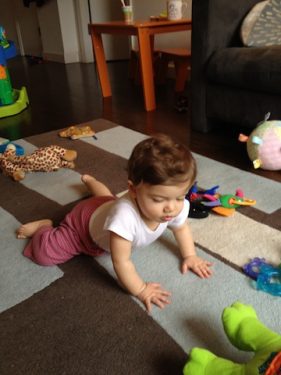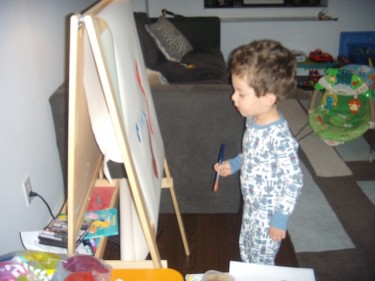By Karinna Dancourt, MS OTR/L at Jumping Jax
As an occupational therapist I often get phone calls from parents asking about their child who is struggling with handwriting. Most of the time, it is the preschool teacher who first calls attention to the child’s fine motor skills. This is logical as preschool is the time children begin to use a pencil to form shapes and write letters. My advice is always to find a way to work fine motor activities into everyday life. This task may seem daunting, so let me explain to you how easy it can be.
 I have an almost 4 year old son, Max, who has been unknowingly working on these “fine motor skills” since he was a baby. In order to be able to hold a pencil or a crayon and move it to form shapes and letters, a child has to have good strength- not just in his hands but throughout his arms and into his shoulders.
I have an almost 4 year old son, Max, who has been unknowingly working on these “fine motor skills” since he was a baby. In order to be able to hold a pencil or a crayon and move it to form shapes and letters, a child has to have good strength- not just in his hands but throughout his arms and into his shoulders.
From infancy, you can help your child develop this strength through simple tummy time activities. Once a baby begins to place his hands flat on the floor and push his chest off the ground, he starts to put weight through his hands. This, in turn, helps to build the arches in his hands- something that is crucial later on in life when he begins to use a pencil for writing tasks. As your baby grows and begins to crawl, he further strengthens his hands by placing even more weight through them.
Your child’s hands need to explore different textures, shapes, and sizes. Offer opportunities for your little one to play with toys such as foam blocks, textured balls, and foamy soap in the tub, and to use his hands to explore different textures such as shaving cream and sand. Allow your child to get messy with his food during mealtime and to use play dough. Of course, you want to make sure these last two activities are kept separate, as we don’t want our little ones eating play dough!
 On the playground, encourage your child to hang on monkey bars or climb on the jungle gym. Offer opportunities for your child to perform activities on a vertical surface. For example, have your child paint or draw on an easel or blackboard. I often recommend that parents tear out pages from coloring books, tape them to the wall, and invite their child to color the pages standing or sitting in front of them.
On the playground, encourage your child to hang on monkey bars or climb on the jungle gym. Offer opportunities for your child to perform activities on a vertical surface. For example, have your child paint or draw on an easel or blackboard. I often recommend that parents tear out pages from coloring books, tape them to the wall, and invite their child to color the pages standing or sitting in front of them.
You can even get a little crazy and paint an entire wall or a portion of a wall with chalkboard paint (my husband still can’t believe I did this one night) and give your child free reign to create whatever he wants. Working on a vertical surface develops and fosters upper body strength and endurance while placing the wrist in an optimal position for fine motor work. As your child learns to hold a crayon, you can offer different types of crayons, such as triangle shaped or chunky crayons. As your child gets a little older, give him small pieces of crayons to hold (In total disclosure here- Max hates it when I break his crayons in half!). When your child colors with these crayon pieces, he is forced to use the smaller muscles of the hand rather than the whole hand to hold and manipulate the crayon.
Bathtime is a great opportunity to “work on” fine motor skills. I often give Max the chance to squirt water out of a water bottle, make shapes on the bathtub wall using shaving cream, and then “erase” his designs by squirting water out of little animal squirt toys. Another great activity is to give your child a thick washcloth and have him ring water out of it.
My most important piece of advice is to encourage your child to have fun exploring and using his hands. Your little one will never even realize that Mommy’s master plan all along was to force him to use every tiny muscle in his hand in order to develop and strengthen fine motor skills!




Comments are closed.